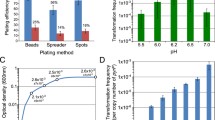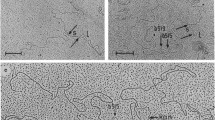Abstract
A transposable element has been isolated from the industrially important fungus Aspergillus niger (strain N402). The element was identified as an insertion sequence within the coding region of the nitrate reductase gene. It had inserted at a TA site and appeared to have duplicated the target site upon insertion. The isolated element was found to be 4798 by in length and contained 37-bp inverted, imperfect, terminal repeats (ITRs). The sequence of the central region of the element revealed an open reading frame (designated ORF1) which showed similarity, at the amino acid level, to the transposase of the Tc1/mariner class of DNA transposons. Another sequence within the central region of the element showed similarity to the 3′ coding and downstream untranslated region of the amyA gene of A. niger. Sequence homology and structural features indicate that this element, which has been named Ant1 (A. niger transposon 1), is related to the Tc1/mariner group of DNA transposons. Ant1 is apparently present as a single copy in strain N402 of A. niger.
Similar content being viewed by others
References
Berg DE, Howe MM (1989) Mobile DNA. American Society for Microbiology, Washington DC
Bos CJ, Debets AJM, Swart K, Huybers A, Kobus G, Slakhorst SM (1988) Genetic analysis and the construction of master strains for assignment of genes to six linkage groups in Aspergillus niger. Curr Genet 14:437–443
Brezinsky L, Wang GVL, Humphreys T, Hunt J (1990) The transposable element Uhu from Hawaiian Drosophila member of the widely dispersed class of Tc1-like transposons. Nucl Acids Res 18:2053–2059
Caizzi R, Caggese C, Pimpinelli S (1993) Bari-1, a new transposonlike family in Drosophila melanogaster with a unique heterochromatic organization. Genetics 133:335–345
Chuck G, Robbins T, Nijjar C, Ralston E, Courtney-Gutterson N, Dooner HK (1993) Tagging and cloning of a Petunia flower color gene with the maize transposable element Activator. Plant Cell 5:371–378
Collins J, Forbes E, Anderson P (1989) The Tc3 family of transposable genetic elements in Caenorhabditis elegans. Genetics 121:47–55
Cove DJ (1966) The induction and repression of nitrate reductase in the fungus Aspergillus nidulans. Biochim Biophys Acta 113:51–56
Cove DJ (1976) Chlorate toxicity in Aspergillus nidulans: the selection and characterisation of chlorate-resistant mutants. Heredity 36:191–203
Cove DJ (1979) Genetic studies of nitrate assimilation in Aspergillus nidulans. Biol Rev 54:291–327
Daboussi M-J, Langin T, Brygoo Y (1992) Fot1, a new family of fungal transposable elements. Mol Gen Genet 232:12–16
Debets F, Swart K, Hoekstra RF, Bos CJ (1993) Genetic maps of eight linkage groups of Aspergillus niger based on mitotic mapping. Curr Genet 23:47–53
Doak TG, Doerder FP, Jahn CL, Herrick G (1994) A proposed superfamily of transposase genes: transposon-like elements in ciliated protozoa and a common “D35E” motif. Proc Natl Acad Sci USA 91:942–946
Fedoroff NV, Furtek DB, Nelson OE (1984) Cloning of the bronze locus in maize by a simple and generalizable procedure using the transposable controlling element Activator (Ac). Proc Natl Acad Sci USA 81:3825–3829
Finnegan DJ (1989) Eukaryotic transposable elements and genome evolution. Trends Genet 5:103–107
Griffin HG, L'Anson KJ, Gasson MJ (1993) Rapid isolation of genes from bacterial lambda libraries by direct polymerase chain reaction screening. FEMS Microbiol Lett 112:49–54
Higgins DG, Sharp PM (1988) CLUSTAL: a package for performing multiple sequence alignment on a microcomputer. Gene 73:237–244
Jacobson JW, Medhora MM, Hartl DL (1986) Molecular structure of a somatically unstable transposable element in Drosophila. Proc Natl Acad Sci USA 83:8684–8688
Jeenes DJ, MacKenzie DA, Roberts IN, Archer DB (1991) Heterologous protein production by filamentous fungi. Biotech Genet Eng Rev 9:327–367
Jones JDG, Bishop G, Carroll B, Dickinson M, English J, Harrison K, Jones D, Scofield S, Thomas CM (1992) Prospects for establishing a tomato gene tagging system using the maize transposon Activator (Ac). Proc Royal See Edin 99B:107–119
Julien J, Poirier-Hamon S, Brygoo Y (1992) Foret1, a reverse transcriptase-like sequence in the filamentous fungus Fusarium oxysporum. Nucleic Acids Res 20:3933–3937
Kachroo P, Leong SA, Chattoo BB (1994) Pot2, an inverted repeat transposon from the rice blast fungus Magnaporthe grisea. Mol Gen Genet 245:339–348
Kinsey JA, Helber J (1989) Isolation of a transposable element from Neurospora crassa. Proc Natl Acad Sci USA 86:1929–1933
Korman DR, Bayliss FT, Barnett CC, Carmona CL, Kodama KH, Royer TJ, Thompson SA, Ward M, Wilson LJ, Berka RM (1990) Cloning, characterization and expression of two α-amylase genes from Aspergillus niger var. awamori. Curr Genet 17:203–212
Langin T, Capy P, Daboussi M-J (1995) The transposable element impala, a fungal member of the Tc1-mariner superfamily. Mol Gen Genet 246:19–28
McHale MT, Roberts IN, Talbot NJ, Oliver RP (1989) Expression of reverse transcriptase genes in Fulvia fulva. Mol Plant-Microbe Interact 2:165–168
McHale MT, Roberts IN, Noble SM, Beaumont C, Whitehead MP, Seth D, Oliver RP (1992) CfT-1: an LTR-retrotransposon in Cladosporium fulvum, a fungal pathogen of tomato. Mol Gen Genet 233:337–347
Prasad SS, Harris LJ, Baillie DL, Rose AM (1991) Evolutionarily conserved regions in Caenorhabditis transposable elements deduced by sequence comparison. Genome 34:6–12
Radice AD, Bugaj B, Fitch DHA, Emmons SW (1994) Widespread occurrence of the Tc1 transposon family: Tc1-like transposons from teleost fish. Mol Gen Genet 244:606–612
Raeder U, Broda P (1985) Rapid preparation of DNA from filamentous fungi. Lett Appl Microbiol 1:17–20
Rosenzweig B, Liao LW, Hirsh D (1983) Sequence of the C. elegans transposable element Tc1. Nucleic Acids Res 11:4201–4209
Sambrook J, Fritsch EF, Maniatis T (1989) Molecular Cloning. Cold Spring Harbor Laboratory Press, Cold Spring Harbor, New York
Tudor M, Lobocka M, Goodell M, Pettitt J, O'Hare K (1992) The pogo transposable element family of Drosophila melanogaster. Mol Gen Genet 232:126–134
Unkles SE, Campbell EI, Carrez D, Grieve C, Contreras R, Fiers W, Van den Hondel CAMJJ, Kinghorn JR (1989) Transformation of Aspergillus niger with the homologous nitrate reductase gene. Gene 78:157–166
Van Luenen HGAM, Colloms SD, Plasterk RHA (1994) The mechanism of transposition of Tc3 in C. elegans. Cell 79:293–301
Varmus H, Brown P (1989) Retroviruses. In: Berg DE, Howe MM (eds) Mobile DNA. American Society for Microbiology, Washington DC, pp 53–108
Verdoes JC, Calil MR, Punt PJ, Debets F, Swart K, Stouthamer AH, Van den Hondel CAMJJ (1994) The complete karyotype of Aspergillus niger: the use of introduced electrophoretic mobility variation of chromosomes for gene assignment studies. Mol Gen Genet 244:75–80
Vos JC, Plasterk RHA (1994) Tc1 transposase of Caenorhabditis elegans an endonuclease with a bipartite DNA binding domain. EMBO J 13:6125–6132
Author information
Authors and Affiliations
Additional information
Communicated by C. A. M. J. J. van den Hondel
Rights and permissions
About this article
Cite this article
Glayzer, D.C., Roberts, I.N., Archer, D.B. et al. The isolation of Ant1, a transposable element from Aspergillus niger . Molec. Gen. Genet. 249, 432–438 (1995). https://doi.org/10.1007/BF00287105
Received:
Accepted:
Issue Date:
DOI: https://doi.org/10.1007/BF00287105




